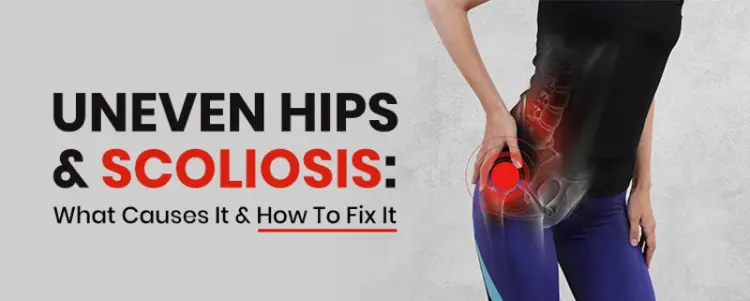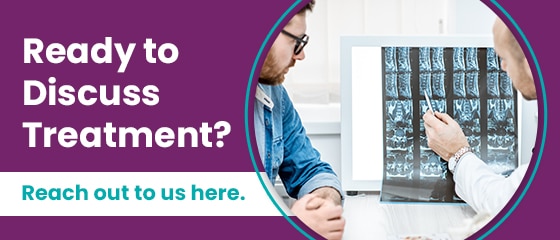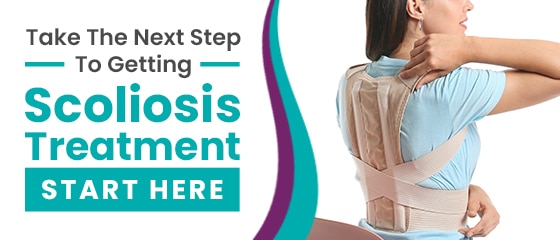The hips are part of the pelvis. Uneven hips are also referred to as ‘lateral pelvic tilt’, and when this happens, one hip can sit higher than the other and/or one hip appears more rounded than the other. Uneven hips are one of the telltale signs of scoliosis.
When uneven hips are scoliosis-related, this is due to the abnormal spinal curvature pulling on the pelvis and distorting its position. Through proactive chiropractic-centered treatment, uneven hips can be addressed as the abnormal spinal curvature is corrected.
When it comes to discussing symptoms of scoliosis, such as uneven hips, it’s important for people to understand just how much the spinal condition can vary from one person to the next. Before we address the specifics of uneven hips, let’s discuss the condition characteristics that contribute to how noticeable postural symptoms can be.
Condition Severity
While there are many factors that go into how a person experiences scoliosis, such as age, fitness level, curvature location, and cause of the condition (if known), perhaps the most significant, in terms of experienced symptoms, is condition severity.
Scoliosis can range between mild, moderate, severe, and very severe. The way we place a condition on its severity scale is through the results of the patient’s scoliosis X-ray.
The scoliosis X-ray, coupled with a comprehensive physical exam and taking of the patient’s medical history, is the primary means by which we learn everything we need to know about a condition to treat if effectively.
Scoliosis X-rays help us diagnose, assess, and monitor a condition throughout treatment to see how the spine is responding.
When it comes to condition severity, a measurement known as ‘Cobb angle’ is taken by drawing intersecting lines from the tops and bottoms of the curvature’s most-tilted vertebrae (bones of the spine).
The intersecting lines form an angle that’s measured in degrees. A patient’s Cobb angle allows us to place their condition on its severity scale of mild, moderate, severe, or very severe.
- Mild scoliosis: Cobb angle measurement of between 10 and 25 degrees
- Moderate scoliosis: Cobb angle measurement of between 25 and 40 degrees
- Severe scoliosis: Cobb angle measurement of 40+ degrees
- Very-severe scoliosis: Cobb angle measurement of 80+ degrees
Condition severity tells us how severe a patient’s condition is and helps us predict likely symptoms and progressive rates. I say ‘likely’ because even with this information, we still can’t predict, with 100-percent accuracy, how a patient’s body is going to respond to the condition and/or treatment, nor can we tell how fast it’s going to progress.
Scoliosis-related symptoms like postural changes are highly dependent on condition severity. As a progressive condition, scoliosis naturally gets worse over time, at varying rates, and as a curvature increases in size and severity, the symptoms it produces tend to become more noticeable as well.
The most common visual signs and symptoms of scoliosis are in the form of postural changes that can affect multiple areas of the body, hips included.
Visual Symptoms of Scoliosis
As mentioned, just as curvature size can vary so significantly from one patient to the next, so too can experienced symptoms and related visual changes.
Adolescent idiopathic scoliosis (AIS) is the condition’s most common form, accounting for 80 percent of known diagnosed cases, which is why for our current purposes, we’ll focus on this type of scoliosis.
In adolescents, the most noticeable telltale signs of scoliosis are related to posture, body symmetry, and the appearance of the shoulders, shoulders blades, back, and hips.
In addition, you might notice that clothes don’t seem to fit as well as they used to. Neck lines can seem to be pulled more to one side, and shirt sleeves and pant legs can appear to be hanging lower on one side than the other.
It’s also fairly common to notice that the distance between the arm and torso is larger on one side than the other.
Other signs and symptoms of scoliosis related to posture include:
- Ribs that protrude more on one side than the other
- Protruding ribs are prominent when in a forward-bend position
- Issues with unevenness during motion
- Arms that are held tightly to the sides during motion
- Head appearing uncentered over the torso
- One shoulder or shoulder blade sitting higher or more prominently than the other
- Legs that appear to be different lengths
- A tiled eye line
- A noticeably crooked spine, especially when in a forward-bend position
- Uneven hips with one sitting higher and/or appearing more rounded than the other
Other non-visual symptoms of scoliosis can include difficulty with balance and coordination, tiredness and fatigue, and pain (in adults).
Pain isn’t commonly a part of the adolescent experience of scoliosis because this age group (between 10 and 18) has yet to reach skeletal maturity. Growing spines are always lengthening, and this motion counteracts the compression caused by an abnormal spinal curvature, which is the underlying cause of scoliosis-related pain.
In adults who have reached skeletal maturity, they are vulnerable to the compression of the spine and its surrounding vessels, nerves, and muscles, and this is what makes scoliosis painful for adults.
So if you’ve seen the signs of scoliosis, such as uneven hips, and been officially diagnosed, what’s next?
Choosing a Scoliosis Treatment Approach
If you or a loved one has received a scoliosis diagnosis, the next step is deciding what type of treatment approach to commit to. This is a big fork in the road on anyone’s scoliosis journey because different treatment approaches offer different outcomes.
There are two main treatment approaches to choose between: traditional and functional.
Traditional Approach
The traditional approach to treating scoliosis has been the dominant approach for many years, but this doesn’t mean it’s the best choice, and fortunately, it’s no longer the only choice.
The issue I have with this approach is that it funnels patients towards spinal-fusion surgery, and this is largely governed by the end goal of traditional scoliosis treatment: to slow/stop progression.
While managing progression is an integral aspect of other treatment approaches as well, including mine, it’s not the same as having ‘correction’ as the end goal of treatment.
In the traditional approach, most often, if a condition is mild, patients are told to watch and wait to see if the condition progresses, but as a progressive condition, we know that virtually every case is going to progress at some point.
We also know that adolescents, entering into or going through puberty, are going to have rapid and unpredictable growth spurts, and growth is the number-one trigger for progression.
In the traditional approach, patients with small curvatures are told to return for X-rays periodically, generally every 3-12 months, depending on the doctor, and those intervals can be even longer. During those intervals, an adolescent can have a huge growth spurt, and their curvature can progress because of growth.
In the traditional approach, bracing is the only proactive form of treatment used prior to when a patient reaches that surgical-level threshold, and then spinal fusion is recommended as the best option.
The traditional braces used in this approach, Boston and Milwaukee, don’t have correction as their end goal, but stopping progression instead, and surgery has the same end goal. There is a big difference between merely stopping a condition from getting worse and actually correcting its underlying cause.
In addition, spinal fusion is irreversible, costly, invasive, and can lead to a number of unpleasant side effects and risk of complications.
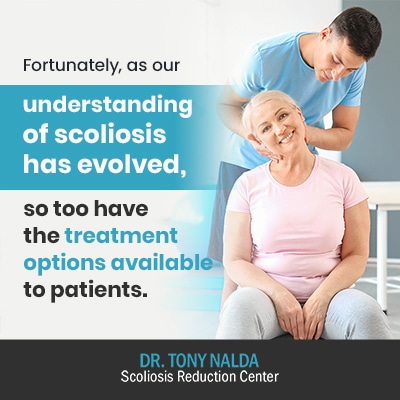 Fortunately, as our understanding of scoliosis has evolved, so too have the treatment options available to patients.
Fortunately, as our understanding of scoliosis has evolved, so too have the treatment options available to patients.
I favor a different approach, one that is less invasive, integrative, more proactive, and with correction and function as its end goal.
In addition, many people are disappointed with the results of spinal fusion on multiple levels, including cosmetics.
Why Doesn’t Scoliosis Surgery Fix Uneven Hips?
While people choose to undergo scoliosis surgery for different reasons, one of the main reasons is cosmetic, meaning people want their pre-scoliosis bodies returned to them after surgery, but this isn’t always a realistic expectation.
I should also add, the end goal of scoliosis surgery (stopping progression) is also not guaranteed.
Uneven hips and scoliosis can be interrelated, as scoliosis may lead to hip problems such as hip sticking out on one side. In some cases, scoliosis can even cause hip arthritis. Additionally, scoliosis-induced uneven ribs and an uneven rib cage may contribute to these issues, but addressing the left side of the problem requires a comprehensive approach to both spinal and hip alignment for effective solutions.
Once a scoliotic spine is fused, cosmetic results can vary based on a number of factors. Where along the spine the curvature was located, condition severity, age of patient, and condition form can all play a role in determining how a patient’s overall posture and body symmetry will respond post-surgery.
Many patients are disappointed that they don’t look the same as they did prior to the onset of their scoliosis, and I have to remind people that fusing the spine is not the same as correcting the spine’s abnormal curvature.
In addition, it can take time for the body to settle into its new posture post-surgery. Potential results also depend on where the curvature was located along the spine. Lumbar curvatures (lower back) can cause an excessive pelvic tilt, making it harder to restore even hips because the pelvic tilt was more extreme at the time of fusion.
All in all, the spine is the focus of spinal-fusion surgery, so while it can succeed in straightening a crooked spine by holding it in place, it can’t always completely restore the symmetry in all related areas of the body, including the hips.
Functional Treatment Approach
Here at the Scoliosis Reduction Center®, I offer patients, and their families, a completely different approach with a different potential treatment outcome based on correction and function.
While managing progression is an important part of my approach, it’s not the end goal: correction is.
So while a traditional approach might be successful in terms of using surgery to straighten a crooked spine and stopping a curvature from getting worse, it is merely holding the spine in a corrective position through artificial means (attaching hardware to the spine to hold it in place while affected vertebrae are fused).
My functional approach is chiropractic-centered and prioritizes preserving the spine’s overall function over curvature size, because the more functional a spine is, the better patients’ quality of life can be moving forward.
As we work towards a curvature reduction, related symptoms, such as uneven hips, are improved upon throughout the process, because the underlying cause of the postural changes is being addressed proactively, effectively, and on a structural level.
How Does Scoliosis Cause Uneven Hips?
Scoliosis is an abnormal sideways curvature of the spine that includes rotation. As mentioned, it’s a progressive condition, meaning it’s in its nature to get worse over time.
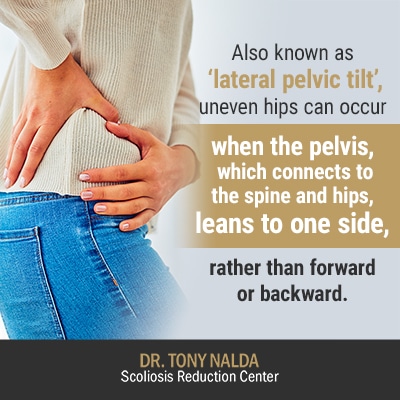 Also known as ‘lateral pelvic tilt’, uneven hips can occur when the pelvis, which connects to the spine and hips, leans to one side, rather than forwards or backwards. This tilt causes one hip to be pulled upwards, while the other is pulled downwards.
Also known as ‘lateral pelvic tilt’, uneven hips can occur when the pelvis, which connects to the spine and hips, leans to one side, rather than forwards or backwards. This tilt causes one hip to be pulled upwards, while the other is pulled downwards.
When this postural change occurs, the hips are no longer sitting parallel to the ground and the shoulders above; this is why uneven hips often present alongside uneven shoulders because as one hip is pulled downwards, the shoulder on the same side of the body is pulled upwards.
As a curvature progresses, increasing in size, the uneven forces introduced to the body are also increasing, and this tends to increase related postural changes like uneven hips and shoulders.
Hypolordosis in the lumbar spine can exacerbate issues like uneven hips and scoliosis, causing discomfort and postural imbalance.
When it comes to the hips, uneven hips are one of the most noticeable symptoms of AIS. This occurs because as a scoliotic spine bends and twists, it pulls on the ribs and pelvis, distorting their position, and this can cause one hip to sit higher than the other and/or cause one hip to appear more rounded, while the other takes on a flatter appearance.
Scoliosis causes uneven hips because of the uneven forces it introduces to the body. To return to treatment, let’s discuss how uneven hips are addressed in proactive treatment.
How are Uneven Hips Caused by Scoliosis Fixed?
When it comes to addressing uneven hips caused by scoliosis, the key is to address its underlying cause: the scoliosis itself.
Here at the Center, we address uneven hips and other related postural scoliosis symptoms by impacting the condition on a structural level, first and foremost.
As scoliosis is structural in nature, this is where the biggest impact has to be made with treatment. Through our functional and chiropractic-centered approach, we work towards reducing the abnormal spinal curvature and increasing core strength so related muscles can better support and stabilize the spine.
My goal is to correct the abnormal curvature and restore as much of the spine’s healthy curves as possible, improving the spine’s overall biomechanics.
As an abnormal curvature is reduced, the adverse pressure causing the related pelvic tilt is relieved, and the hips can start to settle back into a more even position. As the uneven forces exposed to the body, through the scoliotic spine, are reduced, so too are its related postural symptoms.
As a scoliosis chiropractor, I focus on correcting the scoliotic spine’s misalignment through targeted chiropractic adjustments that return each vertebra of the curvature back to where it should be: in alignment with the rest of the spine.
Through scoliosis-specific exercises and stretches that loosen up related muscles, the alignment results can be augmented as the spine gets the support and stabilization it needs from surrounding musculature.
Conclusion
Scoliosis is a complex progressive spinal condition that can range greatly in severity and experienced symptoms.
One of the most common signs of scoliosis are uneven hips, and this develops as the abnormal spinal curvature introduces adverse spinal tension and uneven forces to the body.
When hips are even, they are parallel to the shoulders above and the ground below. As the spine becomes misaligned, it can pull on the rib cage and pelvis, distorting their position and making one hip sit higher than the other.
Through a proactive functional chiropractic-centered approach, we address scoliosis-related symptoms, such as uneven hips, by addressing the underlying structural nature of the condition.
Here at the Scoliosis Reduction Center®, we combine multiple treatment disciplines for the most customized and effective results: chiropractic care, in-office therapy, custom-prescribed home exercises, and specialized corrective bracing.
